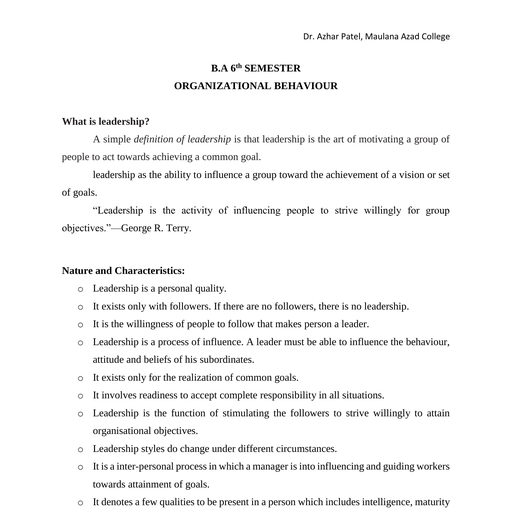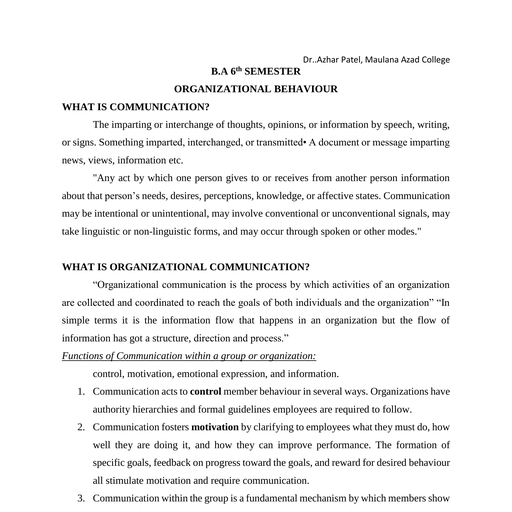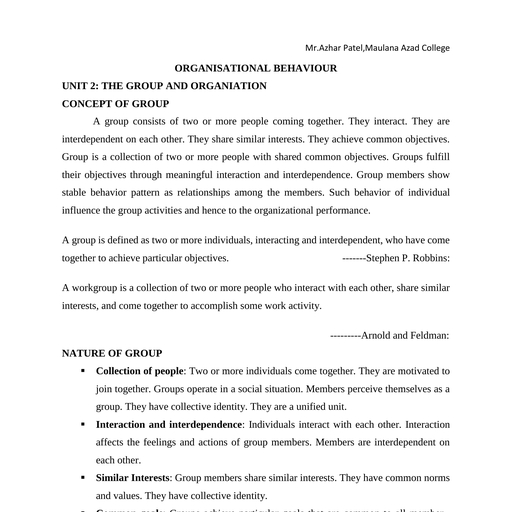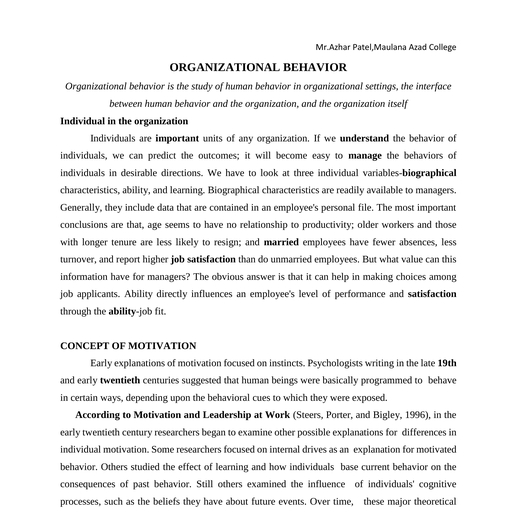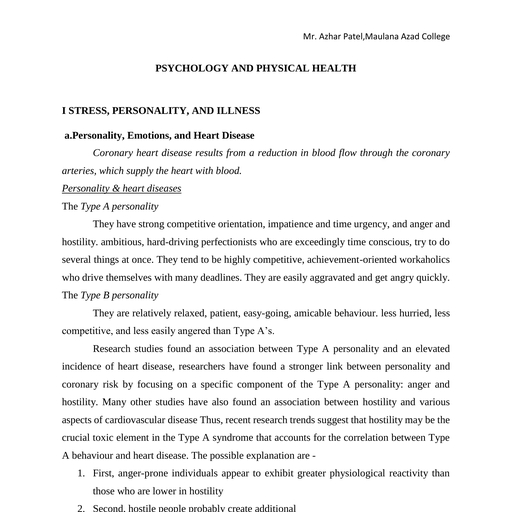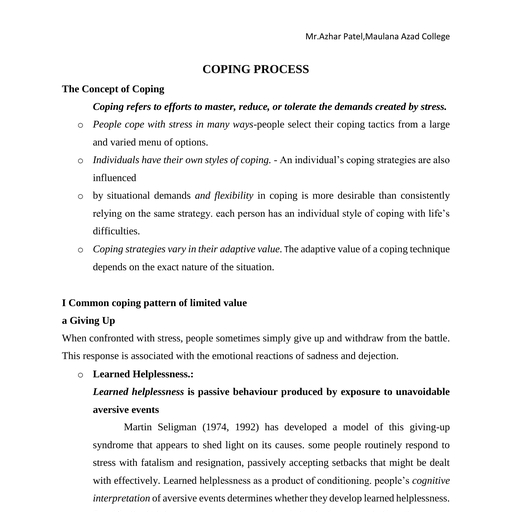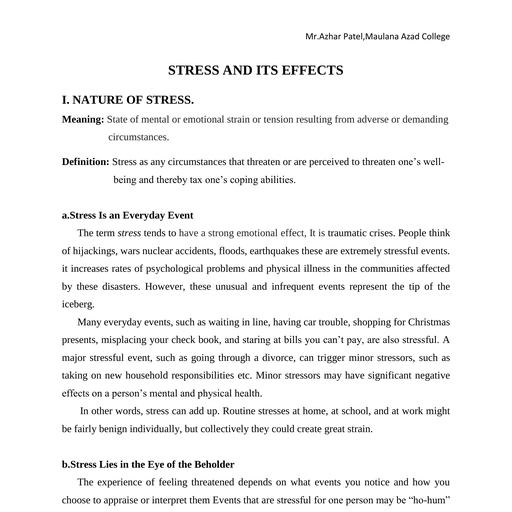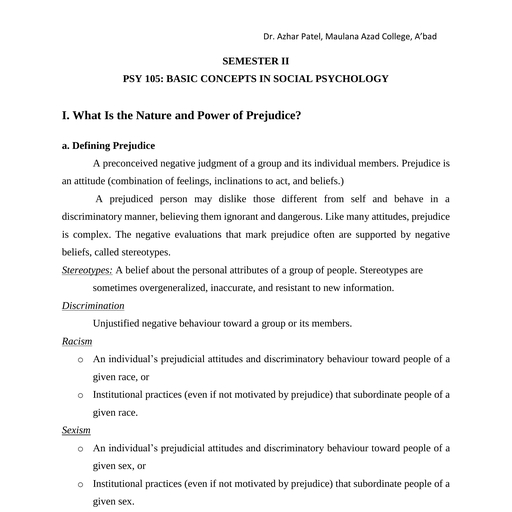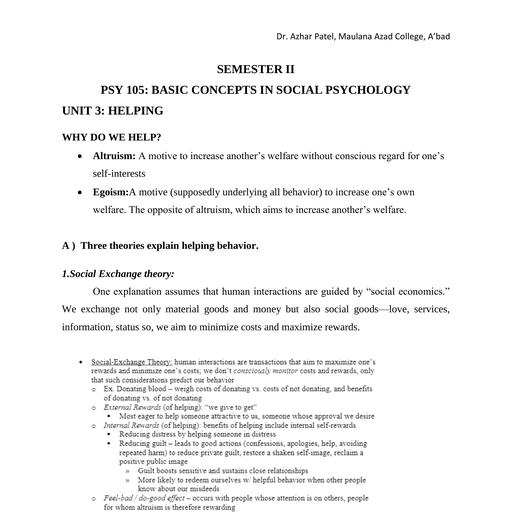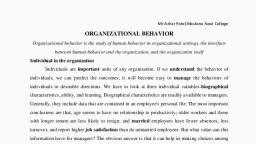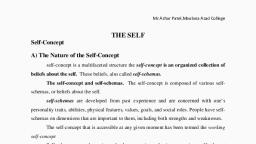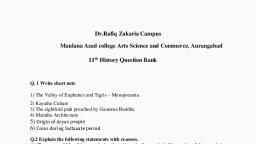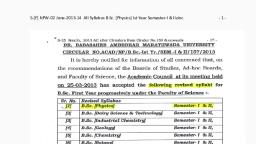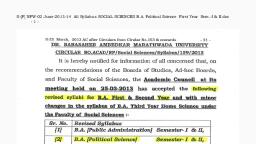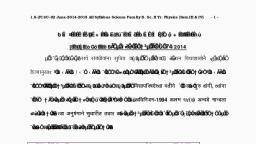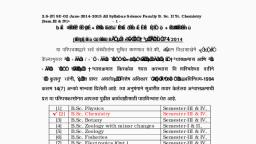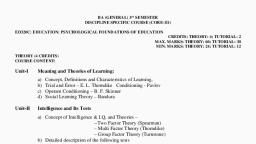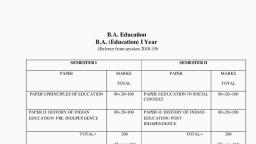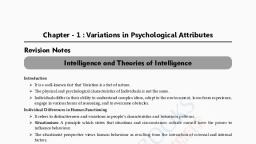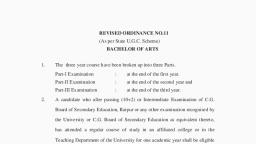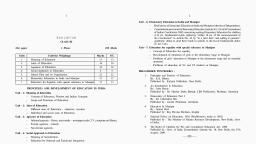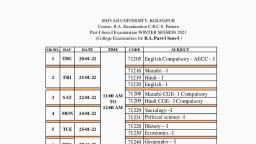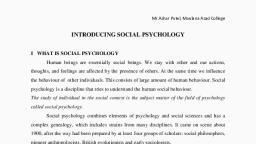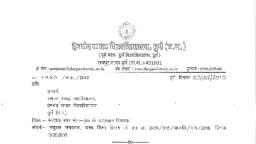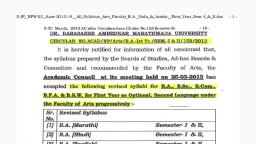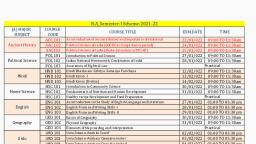Page 1 :
S-[F]NPW-02 June-2013-14 All Syllabus SOCIAL SCIENCES B.A. Psychology Second Year, Sem.III & IV Practical Subject.doc, -1-
Page 2 :
S-[F]NPW-02 June-2013-14 All Syllabus SOCIAL SCIENCES B.A. Psychology Second Year, Sem.III & IV Practical Subject.doc, -2-
Page 3 :
S-[F]NPW-02 June-2013-14 All Syllabus SOCIAL SCIENCES B.A. Psychology Second Year, Sem.III & IV Practical Subject.doc, -3-, , Revised Syllabus of, , B.A. IInd Year, Psychology, Semester-IIIrd & IVth, , [ Effective from -2013-2014 & onwards ]
Page 4 :
S-[F]NPW-02 June-2013-14 All Syllabus SOCIAL SCIENCES B.A. Psychology Second Year, Sem.III & IV Practical Subject.doc, -4-, , Dr. Babasaheb Ambedkar Marathwada University, Aurangabad., PSYCHOLOGY, Curriculum Structure and Scheme of Evaluation for - B. A. III & IV, With effective from 2013-14., SEMESTER – III, Scheme of Teaching, Unit ., , Course, Code, , (Periods/Week), , Name of the, Paper, , Scheme of Evaluation, (Marks), , L, , P, , Total Periods, , Theory, , Practical/, Total, VivaMarks, Voce, , Unit I., , PSY 107, , Psychology of, Adjustment, , 4, , -, , 4, , 30, , -, , 30, , Unit II., , PSY 108, , Psychological, Testing, , 4, , -, , 4, , 30, , -, , 30, , Unit I &, II., , PSY 109, , Psychology :, Practicum's, , -, , 4, , 4, , -, , -, , -, , (A) Total of Semester – III, , 8, , 4, , 12, , 60, , -, , 60, , SEMESTER – IV, Scheme of Teaching, Unit ., , Course, Code, , (Periods/Week), , Name of the, Paper, , Scheme of Evaluation, (Marks), , L, , P, , Total Periods, , Theory, , Pract/, VivaVoce, , Total, Marks, , Unit I., , PSY 110, , Psychology for, Living, , 4, , -, , 4, , 30, , -, , 30, , Unit II., , PSY 111, , Psychological, Statistics, , 4, , -, , 4, , 30, , -, , 30, , -, , 4, , 4, , -, , 80, , 80, , 8, , 4, , 12, , 60, , 80, , 140, , PSY 109, Unit I &, II., , &, PSY 112, , Psychology :, Practicum's, , (B) Total of Semester – IV
Page 5 :
S-[F]NPW-02 June-2013-14 All Syllabus SOCIAL SCIENCES B.A. Psychology Second Year, Sem.III & IV Practical Subject.doc, -5-, , Dr. Babasaheb Ambedkar Marathwada University, Aurangabad., PSYCHOLOGY, SYLLABUS FOR - B.A., With effective from 2013-14., B. A. Third Semester, Course – III, Unit, , Course, Code, , Unit I, , PSY 107, , Psychology of Adjustment, , 30, , Unit II, , PSY 108, , Psychological Testing, , 30, , Unit I & II, , PSY 109, , Psychology :Practicum's, , Title of the Paper, , Marks, , -, , Note: 1., 2., 3., 4., 5., , For theory papers 15 periods., For practical’s 30 periods., One period comprises 50 minutes duration., For Psychology Practicum's. There shall be a batch of 12 students., There shall be a combined Practical Examination of both semesters annually.
Page 6 :
S-[F]NPW-02 June-2013-14 All Syllabus SOCIAL SCIENCES B.A. Psychology Second Year, Sem.III & IV Practical Subject.doc, -6-, , Syllabus for B.A. (Semester-III), Course III, Unit I, PSY 107 – PSYCHOLOGY OF ADJUSTMENT, With effect from 2013-2014., Marks-30, Objectives: 1. To enable student to make the connection between psychology and its practical, application to everyday life., 2. To train student how psychological principles can help them to face life’s challenges, 3. To enables students to relate what they are learning in class to issues that they encounter, in their everyday life, such as stress, health, work, personal relationships, communication, and self-esteem., 1), , INTERPERSONAL COMMUNICATION: i) THE PROCESS OF INTERPERSONAL COMMUNICATION, (a) Components of the communication process, (b) Communication and adjustment, ii) NONVERBAL COMMUNICATION, (a) General principles, (b) Elements of nonverbal communication, (c) Detecting deception, (d) The significance of nonverbal; communication, iii) COMMUNICAITON PROBLOEMS, (a) Communication apprehension, (b) Barriers to effective communication, iv) INTERPERSONAL CONFLICT, (a) Beliefs about conflict, (b) Types of conflict, (c) Styles of managing conflict, (d) Dealing constructively with conflict, (e) Public communication in an adversarial culture, v) APPLICATION: DEVELOPING AN ASSERTIVE COMMUNICATION, (a) The nature of assertiveness, (b) Steps in assertiveness training
Page 7 :
S-[F]NPW-02 June-2013-14 All Syllabus SOCIAL SCIENCES B.A. Psychology Second Year, Sem.III & IV Practical Subject.doc, -7-, , 2) FRIENDSHIP AND LOVE: i. PERSPECTIVES ON CLOSE RELATIONSHIPS, a. The ingredients of close relationships, b. Culture and relationships, c. The internet and relationships, ii. INITIAL ATTRACTION AND RELATIONSHIP DEVELOPMENT, a. Initial encounters, b. Getting acquainted, c. Established relationships, iii. FRIENDSHIP, a. What makes a good friend?, b. Gender differences in friendship, iv. ROMANTIC LOVE, a. Myths about love, b. Gender differences regarding love, c. Theories of love, d. The course of romantic love, v., APPLICATION: OVERCOMING LONELINESS, a. The nature of loneliness, b. Prevalence of loneliness, c. The roots of loneliness, d. Correlates of loneliness, e. Conquering loneliness, 3) MARRIGE AND INTIMATE RELATIONSHIP: i. CHALLENGES TO THE TRADIATIONAL MODEL OF MARRIGE, ii. MOVING TOWERD MARRIGE, a. The motivation to marry, b. Selecting to mate, c. Predictors of marital success, iii.MARITAL ADJUSTMENT ACROSS THE FAMILY LIFE CYCLE, a. Between families: The unattached young adult, b. Joining together: The newly married couple, c. Family with young children, d. Launching children into the adult world, e. The family in later life, iv. VULNERABLE AREAS IN MARITAL ADJUSTMENT, a. Gaps in role expectations, b. Work and carrier issues, c. Financial difficulties, d. In2adequate communication, v. DIVORCE, a. Increasing rate of divorce, b. Deciding on a divorce, c. Adjusting to divorce, d. Remarriage, vi. APPLICATION: UNDERSTANDING INTIMATE VOILENCE, a. Partner abuse, b. Child abuse
Page 8 :
S-[F]NPW-02 June-2013-14 All Syllabus SOCIAL SCIENCES B.A. Psychology Second Year, Sem.III & IV Practical Subject.doc, -8-, , 4) CAREERS AND WORK: i. CHOOSING A CAREER, a. Examining personal characteristics and influences, b. Researching job characteristics, c. Using psychological tests for career decisions, d. Taking important considerations into account, ii. MODELS OF CAREER CHOICE AND DEVELOPMENT, a. Holland’s trait measurement and matching model, b. Super’s developmental model, c. Women’s career development, iii. THE CHANGING WORLD OF WORK, a. Workplace trends, b. Education and earnings, c. The changing workforce, iv. COPING WITH OCCUPATIONAL HAZARDS, a. Job stress, b. Sexual harassment, c. Unemployment, v., BALANCING WORK AND OTHER SPHERES OF LIFE, a. Workaholism, b. Work and family roles, c. Leisure and recreation, vi. APPLICATION: GETTING AHEAD IN THE JOB GAME, a. Putting together a resume, b. Finding companies you want to work for, c. Landing an interview, d. Polishing your interview technique, Books for Readings:1. Weiten, W., Lloyd A. M. (2004). Psychology Applied to modern Life: Adjustment, in the 21st Century. (7th Ed) Singapore: Thomson Wadsworth Pvt ltd., 2. Psychology for Living, Adjustment, Growth, and Behaviour today- By Eastwood, Atwater Prentice hall of India Private Limited, New Delhi, 5th Edition-1995., 3. Colemen, J.C. Psychology and effective bahaviour, Bombay: D.B. Taraporevala, Sons & Co., 4. Lazarus, R.S. Patterns of adjustment, N.D. : McGraw-Hill, 5. Martin, L.G.; Osborne, G. (1989). Psychology: Adjustment and everyday living,, N.J.: Prentice-Hall, Englewood Cliffs., 6. Gray, S.W. and Zide, M.R. India Edition (2008). Psychology: A competency based, assessment model for social workers. Thomson Group Pole., 7. Dimatteo, M.R. and Martin, L.R. (2002). Health Psychology. N.D.: Pearson., 8. Brannon, L. and Feist, J. (2007). Introduction to health psychology. India ed. N.D.:, Thomson., 9. Marks, D.; Murray, M.; Evans, B.; Willig, C.; Woodall, C. and Sykes, C. (2005)., 2nd ed. Health psychology: Theory, research and practice. N.D. : Sage Pub.
Page 9 :
S-[F]NPW-02 June-2013-14 All Syllabus SOCIAL SCIENCES B.A. Psychology Second Year, Sem.III & IV Practical Subject.doc, -9-, , Syllabus for B.A. (Semester-III), Course III, Unit I, PSY 108 – PSYCHOLOGICAL TESTING, With effect from 2013-14., Marks-30, Objectives: 1. To train students in various psychological assessment techniques., 2. To acquaint the student and make them understand the different statistical methods, with their uses and interpretations., 3. To impart skills necessary for selecting and applying different tests for different, purpose such as evaluation, training, rehabilitation etc., 1) USES AND IMPLICATIONS OF PSYCHOLOGICAL TESTING, i) Functions of psychological tests, ii) Nature of a psychological test, iii) Controlling the Use of tests, iv) Test administration, v), , Examiner and situational variables, , vi) Effect of training on test performance, vii) Social and ethical implication of testing, viii) Test anxiety and rapport, ix) Types of psychological tests, 2) ITEM ANALYSIS, i) Item difficulty, ii) Item discrimination, iii) Indices of item discrimination, iv) Item response theory, v), , Item analysis of speeded tests, , vi) Cross validation, vii) Item-by-group interaction
Page 10 :
S-[F]NPW-02 June-2013-14 All Syllabus SOCIAL SCIENCES B.A. Psychology Second Year, Sem.III & IV Practical Subject.doc, - 10 -, , 3) RELIABILITY OF PSYCHOLOGICAL TEST, i), , Definition, , ii) The correlation coefficient, iii) Types of reliability:, (a) Test-retest reliability, (b) Parallel from reliability,, (c) Split-half reliability, (d) Inter-item consistency, iv) Scorer reliability, v), , Reliability of speeded tests, , vi) Factors affecting reliability coefficients, vii) Standard error of measurement, viii) Reliability of criterion-referenced tests, 4) VALIDITY OF PSYCHOLOGICAL TESTS, i) Meaning of validity, ii) Types of validity, (a) Content validation, (b) Criterion-related validation, (c) Construct validation, iii) Comparison of validation procedures, iv) Validity, Books for Readings:1. Anastasi A (1997) Psychological Testing, New York: Mac Millan Co., 2. Cimnero, A.R. (1986) Hand book of Behavioural Assessment New York : John, Wiley., 3. Freeman.Frank S (1971) Theory and Practice of Psychological Testing Oxford &, IBH Publishing Co. New Delhi., 4. Dandekar, W.N. & Rajguru, M.S. ( ) An Introduction to Psychological testing &, statistics, Seth Publication, 5. Psychological Testing, Principles, Applications, and Issues, Robert M. Kaplan &, Dennis P. Saccuzzo, Sixth Edition, 2005., 6. Psychological testing, A practical approach to Design and Evaluation, Theresa,, J.B. Kline, Sage publications, 2005., 7. Statistics in Psychology and education, H.E. Garrett, Vakil and Ferrar Company,, Bombay, 1966., 8. Statistics in Psychology and Education, J.S. Gaiford, International Student Edn.,, McGraw Hill., 9. Statistical Reasoning in Psychology & Education IIIrd Edn. John Wiley & Sons, 2001., 10. Edward G. Minum Bruce M. King Gordon Bear: Statistical Methods for Practice, & research A Guide to data Analysis using SPSS Ajai S Gaur Sanjay S. Gaur, 2nd, Edn. Sage-2006.
Page 11 :
S-[F]NPW-02 June-2013-14 All Syllabus SOCIAL SCIENCES B.A. Psychology Second Year, Sem.III & IV Practical Subject.doc, - 11 -, , Dr. Babasaheb Ambedkar Marathwada University, Aurangabad., PSYCHOLOGY, SYLLABUS FOR - B.A., With effective from 2013-2014., B. A. Fourth Semester, Course – IV, Unit, , Course, Code, , Unit I, , PSY 110, , Psychology for Living, , 30, , Unit II, , PSY 111, , Psychological Statistics, , 30, , Unit I & II, , PSY 109 &, PSY 112, , Title of the Paper, , Psychology :, Practicums, , Marks, , 80, , Note: 1., 2., 3., 4., , For theory papers 15 periods., For practical’s 30 periods., One period comprises 50 minutes duration., For Psychology Practicums. There Shall be a batch of 20 students.
Page 12 :
S-[F]NPW-02 June-2013-14 All Syllabus SOCIAL SCIENCES B.A. Psychology Second Year, Sem.III & IV Practical Subject.doc, - 12 -, , Syllabus for B.A. (Semester-IV), Course IV, Unit I, , PSY 110 – PSYCHOLOGY FOR LIVING, With effect from 2013-14., Marks-30, Objectives: 1. To enable student to make the connection between psychology and its practical, application to everyday life., 2. To train student how psychological principles can help them to face life’s challenges, 3. To enables students to relate what they are learning in class to issues that they encounter, in their everyday life, such as stress, health, work, personal relationships communication, and self-esteem., 1) THE SELF: i. SELF – CONCEPT, a. The Nature Of The Self – Concept, b. Self-discrepancies, c. Factors shaping the self-concept, ii. SELF – ESTEEM, a. The importance of self-esteem, b. Determinants of self – esteem, c. Ethnicity, gender, and self-esteem, iii. BASIC PRINCIPLES OF SELF-PERCEPTION, a. Cognitive processes, b. Self-attributions, c. Attribution style, d. Motives guiding self-understanding, e. Methods of self-enhancement, iv. SELF-REGULATION, a. Self-efficacy, b. Self-defeating behavior, v. SELF-PRESENTATION, a. Impression management, b. Self- monitoring, vi. APPLICATION: BUILDING SELF-ESTEEM
Page 13 :
S-[F]NPW-02 June-2013-14 All Syllabus SOCIAL SCIENCES B.A. Psychology Second Year, Sem.III & IV Practical Subject.doc, - 13 -, , 2) STRESS AND IT’S EFFECTS: i. THE NATURE OF STRESS, a. Stress is an everyday event, b. Stress lies in the eye of the beholder, c. Stress may be embedded in the environment, d. Stress may be self-imposed, e. Stress is influenced by culture, ii. MAJOR TYPES OF STRESS, a. Frustration, b. Conflict, c. Change, d. Pressure, iii. RESPONDING TO STRESS, a. Emotional response, b. Physiological responses, c. Behavioral response, iv. THE POTENTIOAL EFFECTS OF STRESS, a. Impaired task performance, b. Disruption of cognitive functioning, c. Burnout, d. Posttraumatic stress disorders, e. Psychological problems and disorders, f. Physical illness, g. Positive effects, v. FACTORS INFLUENCING STRESS TOLERANCE, a. Social support, b. Hardiness, c. Optimism and conscientiousness, vi. APPLICATION: MONITORING YOUR STRESS, a. Problems with the SRRS, b. The life experiences survey, c. A Cautionary Note, 3) COPING PROCESSES: i. COMMON COPING PATTERNS OF LIMITED VALUE, a. Giving up, b. Striking out at others, c. Indulging yourself, d. Blaming yourself, e. Using defensive coping, ii. THE NATURE OF CONSTRUCTIVE COPING, iii. APPRAISAL-FOCUSED CONSTRUCTIVE COPING, a. Ellis’s rational thinking, b. Humor as a stress reducer, c. Positive reinterpretation, iv. PROBLEM-FOCUSED CONSTRUCTIVE COPING, a. Using systematic problem solving, b. Seeking help, c. Using time more effectively, d. Improving self-control
Page 14 :
S-[F]NPW-02 June-2013-14 All Syllabus SOCIAL SCIENCES B.A. Psychology Second Year, Sem.III & IV Practical Subject.doc, - 14 -, , v. EMOTION-FOCUSED CONSTRUCTIVE COPING], a. Releasing pent-up emotions, b. Distracting yourself, c. Managing hostility and forgiving others, d. Meditating, e. Using relaxation procedures, vi. APPLICATION: ACHIEVING SELF-CONTROL, a. Specifying your target behavior, b. Gathering baseline data, c. Designing your program, d. Executing and evaluation your program, e. Ending your program, 4) PSYCHOLOGY AND PHYSICAL HEALTH: i. STRESS, PERSONALITY AND ILLNESS, a. Personality, emotions, and heart disease, b. Stress and cancer, c. Stress and other diseases, d. Stress and immune functioning, e. Conclusions, ii. HABITS, LIFESTYLES, AND HEALTH, a. Smoking, b. Drinking, c. Overeating, d. Poor nutrition, e. Lack of exercise, f. Behaviour and AIDS, iii. REACTIONS TO ILLNESS, a. The decision to seek treatment, b. The sick role, c. Communicating with health provides, d. Adherence to medical advice, iv. APPLICATION: UNDERSTANDING THE EFFECTS OF DRUGS, a. Drug-related concepts, b. Narcotics, c. Sedatives, d. Stimulants, e. Hallucinogens, f. Marijuana, g. Ecstasy (MDMA)
Page 15 :
S-[F]NPW-02 June-2013-14 All Syllabus SOCIAL SCIENCES B.A. Psychology Second Year, Sem.III & IV Practical Subject.doc, - 15 -, , Books for Readings:1. Weiten, W., Lloyd A. M. (2004). Psychology Applied to modern Life: Adjustment, in the 21st Century. (7th Ed) Singapore: Thomson Wadsworth Pvt ltd., 2. Psychology for Living, Adjustment, Growth, and Behaviour today- By Eastwood, Atwater Prentice hall of India Private Limited, New Delhi, 5th Edition-1995., 3. Colemen, J.C. Psychology and effective bahaviour, Bombay: D.B. Taraporevala, Sons & Co., 4. Lazarus, R.S. Patterns of adjustment, N.D. : McGraw-Hill, 5. Martin, L.G.; Osborne, G. (1989). Psychology: Adjustment and everyday living,, N.J.: Prentice-Hall, Englewood Cliffs., 6. Gray, S.W. and Zide, M.R. India Edition (2008). Psychology: A competency based, assessment model for social workers. Thomson Group Pole., 7. Dimatteo, M.R. and Martin, L.R. (2002). Health Psychology. N.D.: Pearson., 8. Brannon, L. and Feist, J. (2007). Introduction to health psychology. India ed. N.D.:, Thomson., 9. Marks, D.; Murray, M.; Evans, B.; Willig, C.; Woodall, C. and Sykes, C. (2005)., 2nd ed. Health psychology: Theory, research and practice. N.D. : Sage Pub.
Page 16 :
S-[F]NPW-02 June-2013-14 All Syllabus SOCIAL SCIENCES B.A. Psychology Second Year, Sem.III & IV Practical Subject.doc, - 16 -, , Syllabus for B.A. (Semester-IV), Course IV, Unit II, , PSY 111 – PSYCHOLOGICAL STATISTICS, With effect from 2013-14., Marks-30, Objectives: 1. To train students in various psychological assessment techniques., 2. To acquaint the student and make them understand the different statistical methods, with their uses and interpretations., 3. To impart skills necessary for selecting and applying different tests for different, purpose such as evaluation, training, rehabilitation etc., 1) FREQUENCY DISTRUBUTIONS, i. Measurement in general, ii. Need for grouping, iii. Preparation of a frequency table, iv. Graphic representations of the frequency distribution, a. Histogram, b. Frequency Polygon, v. Smoothing a polygon, 2) MEASURES OF CENTRAL TENDENCY., i. Mean, ii. Computation of the mean, a. The long method and, b. The short or assumed mean method, iii. Median and its computation, iv. Mode, v. Uses of various measures of central tendency, 3) MEASURES OF VARIABILITY, i. Range, ii. Quartile deviation, iii. Average deviation, iv. Standard deviation, v. Uses of the various measures of variability, 4) MEASURES OF ASSOCIATION, i) Meaning and types of coefficient of correlation., ii) Rank Difference Correlation., iii) Product Moment Correlation (Ungrouped)
Page 17 :
S-[F]NPW-02 June-2013-14 All Syllabus SOCIAL SCIENCES B.A. Psychology Second Year, Sem.III & IV Practical Subject.doc, - 17 -, , Books for Readings:1. Anastasi A (1997) Psychological Testing, New York: Mac Millan Co., 2. Cimnero, A.R. (1986) Hand book of Behavioural Assessment New York : John, Wiley., 3. Freeman.Frank S (1971) Theory and Practice of Psychological Testing Oxford &, IBH Publishing Co. New Delhi., 4. Dandekar, W.N. & Rajguru, M.S. ( ) An Introduction to Psychological testing &, statistics, Seth Publication, 5. Psychological Testing, Principles, Applications, and Issues, Robert M. Kaplan &, Dennis P. Saccuzzo, Sixth Edition, 2005., 6. Psychological testing, A practical approach to Design and Evaluation, Theresa,, J.B. Kline, Sage publications, 2005., 7. Statistics in Psychology and education, H.E. Garrett, Vakil and Ferrar Company,, Bombay, 1966., 8. Statistics in Psychology and Education, J.S. Gaiford, International Student Edn.,, McGraw Hill., 9. Statistical Reasoning in Psychology & Education IIIrd Edn. John Wiley & Sons, 2001., 10. Edward G. Minum Bruce M. King Gordon Bear: Statistical Methods for Practice, & research A Guide to data Analysis using SPSS Ajai S Gaur Sanjay S. Gaur, 2nd, Edn. Sage-2006.
Page 18 :
S-[F]NPW-02 June-2013-14 All Syllabus SOCIAL SCIENCES B.A. Psychology Second Year, Sem.III & IV Practical Subject.doc, - 18 -, , Syllabus for B.A. (Semester- III & IV), Course III, Unit I & II, PSY 109 & PSY 112 – PSYCHOLOGY PRACTICUM'S, With effect from 2013-14., Objectives, 1. To create interest in psychological phenomenon., 2. To develop awareness of psychological of psychological tools, techniques and tests., 3. To nurture the skill of observation., Section - A, Total Tests – 16, , Marks- 80, , A), , Intelligence / Aptitude (Any Two), i) General Mental Alertness Test: - R. P. Shrivastava, ii) Teaching Aptitude Test, iii) Science Aptitude Test, iv) A Group Intelligence (EGMAT): - S. Jalota, v) Mangal Emotional Intelligence Inventory (MEII): - S. K. Mangal, vi) Draw A Man Test Children: - Pramila Pathak, vii) Culture Fair (Free) Intelligence Scale – Indian Adaptation: Kapoor, Rao & Singh, viii) Malin's Indian Adaptation of Weschler Intelligence Test of Children, , B), , Interest / Study Habit (Any Two), i) Multiphasic Interest Inventory: - S. K. Bhava, ii) Interest test, iii) Vocational Interest record: -S. P. Kulshrestha, iv) Test of study habits and Attitudes., v) Adolescent Interest Test: - H. A. David, vi) Leadership Preference Scale: - L. I. Bhusan, vii) Multi Factor Interest Questionnaire: - Kapoor and Singh, , C), , Attitude (Any Two), i) Optimistic Pessimistic Scale, ii) Secular Attitude Scale, iii) Vocational Attitude Scale: - H. C. Bhasin, iv) Attitude scale towards education., v) A new test of values, vi) Social value Test: - H. P. Shrivastava
Page 19 :
S-[F]NPW-02 June-2013-14 All Syllabus SOCIAL SCIENCES B.A. Psychology Second Year, Sem.III & IV Practical Subject.doc, - 19 -, , D) Carrier & family (Any Two), i), ii), iii), iv), v), vi), , E), , F), , G), , Traditional family ideology scale (TFIS) – B. C. Muthyya, Family relationship scale – Govind Tiwari, Attitude toward communication job – Dr. O. S. Rathore, Dr. Mandra & Dr. Mathur, Marital adjustment questionnaire – P. Kumar & K. Rohatagi., Career Decision Scale (CDS)., Perceived parenting style (P Scale) Rajeev Lochan Bharadwaj, Harish Sharma &, Amita Garg, , Personality Test (Any Two), i) Multi Variable Personality Inventory, ii) Personality Inventory, iii) KNPI, iv) Differential Personality Inventory, v) Multi Dimensional Assessment of Personality Series (MAP), Adjustment / Interest (Any Three), i) Adjustment Inventory for School Students, ii) Revised Adjustment Inventory, iii) Educational Interest Record, iv) Old age adjustment, v) Social Adjustment, vi), Adjustment Inventory for college students, vii) Youth problem Inventory, Self Related Test (Any Three), i) Self acceptance Scale, ii) Ego Strength scale, iii) Self Perception scale, iv) Satwa Bodh Parikshan, v) Self Confidence Inventory, vi) Self Disclosure Inventory, vii) Self actualization Inventory, viii) Self concept questionnaire, , Section-B, Test Construction: A report shall be submitted at the time of practical examination., Distribution of Marks, Section-A, , Section-B, , Procedure, , Viva, , Report, , 15, , 15, , 20, , Record, Book, (Internal), 10, -=**=-, , S*/-150513/-, , Viva, 10, , (Internal), 10, , Total, 80

